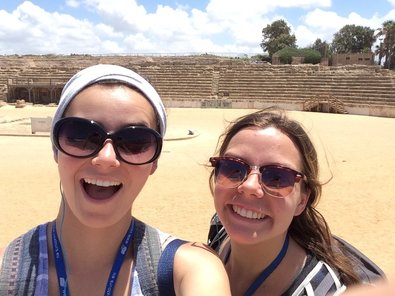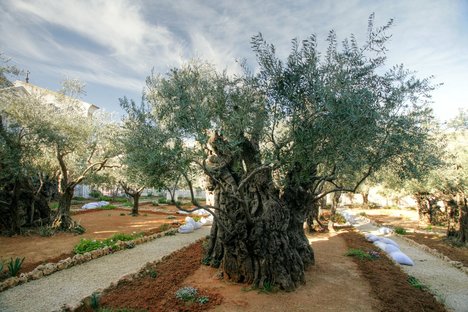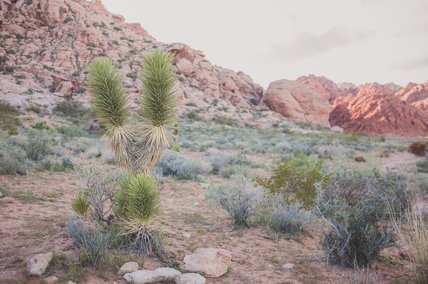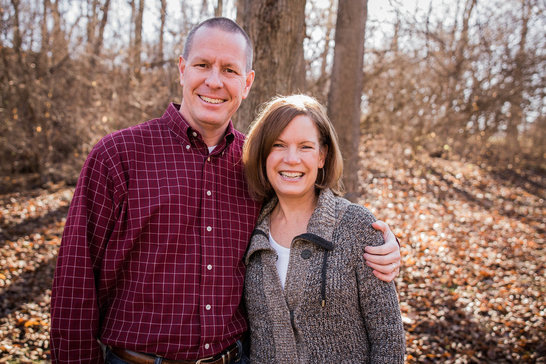|
Author: Taylor Abigail The shade was much needed after a morning of trekking. In Israel, the heat is dry and deceiving - often it is much hotter than you think. We had just explored a replica of a biblical town - complete with houses, wheat fields, and even meandering goats! I was touring all over Israel with a group hungry to learn. Our topic of study was women in the Bible. After walking the town, our guide brought us to the shade and asked us to open to Proverbs 31.
Over the years, Christian women have attached baggage to this particular passage. Whether teaching has abused the text or not, for me, Proverbs 31 is the description of the woman I could never be, yet, the one I am expected to be. My adrenaline began to pump at my guide's request, but I decided to trust him. Our guide was a 70-year-old Messianic Jew who had lived in Israel all his life. A Hebrew- speaking and Hebrew-Bible-reading man of God, I hoped that he would shed new light on this worn (in my mind) passage. I wanted to find the truth from Proverbs 31. I want to be at peace with all things in The Word. I humbled myself and let the Holy Spirit move as our guide began. Hebrew reads from right to left. It's reminiscent of chiseling words into stone. The mason would hold the chisel in the left hand, and come down with the hammer in his right hand. This forced the movement across the stone from right to left. The permanence and force with which this language had been recorded for centuries can also be found in the words themselves. Each word is richly nuanced, specific, and poetic. Line by line from the Hebrew Bible our guide drew out truth, mercy, and grace from Proverbs 31. A concept that is much more present in the Hebrew is the sense of partnership between the husband and wife. But not the partnership we might think of today. In Jewish culture, the men were out studying the Torah, while the women were truly the child-rearers/bearers, and managers of the house. If their husbands were well respected in the city, their homes would be large; filled with many children and servants. Their partnership was much more about the encouragement they gave one another in their respective duties rather than splitting the work evenly. Solomon, the writer of Proverbs, a wealthy king, wrote chapter 31 about the ideal Jewish woman - a woman who from her youth understood that she was (quite literally) going to be the lone queen of her castle while her king waged war and ruled in the city. As Solomon wrote about this ideal Jewish woman - complete with strong arms and the ability to stay up late AND rise up early day after day - he starts and ends the chapter with the most important things. He begins, "A wife of noble character who can find?" and ends, "Charm is deceptive and beauty is fleeting but a woman who fears the Lord is to be praised." These bookends are timeless. Solomon, king of 1000 women in his palace, knew that the "ideal Jewish woman" whom he described could not be found. But what he did find among the 1000, was that those who feared the Lord - not those who started and owned multiple business, not those who had 10 children, not those who kept every crevice of the palace clean, and not even those who were the most beautiful - but those who feared the Lord - were worthy of praise. While we tend to teach Proverbs 31 as the way to be a godly Christian woman, the true wisdom and message of Proverbs 31 is that amidst the impossible standards for women, that the fear of the Lord frees us from them all. A woman of wisdom will remember these bookends and cling to them for their freedom. We do not need to be found perfect, we need only fear the Lord. Like the dry heat, an English translation of a Hebrew Bible can veil the truth. I'm so thankful that I experienced a taste of the fullness of Hebrew. As my guide finished his teaching on the chapter, my anxiety ceased and a new relief washed over me. No longer does this chapter represent standards to be met and surpassed. It now stands to remind me to continually stand in the grace of Christ who has called me worthy by His blood. by Patricia Stirnkorb, guest author, as published in the spring 2017 issue of Live magazine Experience Israel with Live with Heart & Soul! Secure your spot for a once-in-a-lifetime pilgrimage to the Holy Land in February 2018! Click here to learn more. Above: the Garden of Gethsemane Stepping off the plane in Ben Gurion Airport, Tel Aviv, Israel, was like stepping off any plane ride to any other city in the world. But the realization that we had now entered the "Holy Land" brought goosebumps.
This is the land that God selected for His people - and I was walking on it. Ezekiel tells us, "On that day, I raised My hand in an oath to them, to bring them out of the land of Egypt into a land that I had searched out for them, 'flowing with milk and honey,' the glory of all lands." Ezekiel 20:6. God didn't just allow the Israelites to wander for 40 years and then grab a piece of barren land. He searched it out for them - a special land flowing with milk and honey, the glory of all lands! Israel! Sacred to Him in 1400 BC and sacred to Him today. In my mind, Israel was a desert - dry, parched, brown. Yet I knew from studies that God allowed His people to farm it and that water sprang forth to produce crops. I had no idea how amazing this land was that He gave them. Geographically, Israel is close to the size of New Hampshire: 8,019 square miles, a mere 263 miles top to bottom, 114 miles at its widest, 9 miles at the narrowest. Of that, the Negev desert consumes 6,178 square miles, more than half of the country. Yet in this land, there are five growing seasons which produce 95% of all food consumed in Israel. When the Israelites began returning to the region in the late 19th century, they purchased mostly semi-arid land. Much of it was untillable. They set about cleaning, clearing, terracing, irrigating and desalinizing the land to make it farmable. The diversity of the climate in this country allows them to produce almost every type of fruit and vegetable. in 1948 when Israel was proclaimed an independent country, 408,000 acres was tillable; today they farm more than a million acres! Israel's coastal zone produces citrus, bananas, coconuts, avocados, kiwi, mangoes, guavas and grapes from orchards near the Mediterranean. Basic garden vegetables like tomatoes, cucumbers, peppers and zucchini are grown pretty much everywhere. Melons are grown in the winter months in the valleys. Subtropical areas produce bananas, dates, and coconuts, and in the northern hills, apples, pears, and cherries are plentiful. Grape vineyards are found across the country which has allowed the wine industry to flourish. Even field crops like wheat, sorghum, and corn are grown. They also grow cotton on drip-irrigated land which produces some of the highest yields per acre of anywhere in the world. And this is not a complete list. Open-air markets in the cities bring home-grown fruits and vegetables like strawberries and greens. Imagine one small state, more than half of it a desert, producing crops that are unique to only parts of our large country! We passed miles of green houses on our trip across Israel. In fact, about 25% of their crops are grown in greenhouses or covered structures. Most people travel to Israel with the intent of learning, seeing and experiencing the connection between God and His people, seeing the places where Jesus walked, lived, taught, and was crucified. Of course, the magnitude of that cannot be diminished as Judaism influences all other religions in the world. But, we need to realize that "behind the scenes" God provided exactly what His chosen people needed to survive. The land of milk and honey produces honey dates which are the sweetest in the world - honey from the date flowers, which is exceptional - and milk from their livestock produces more gallons per cow than any other livestock in the world (without antibiotics or growth hormones!). They export much of what they grow. They import very little: coffee, oilseeds, meat, cocoa and sugar. In fact, 95% of all they need comes from their own country. It is not an accident that His people have come home to the land that God selected for them. We traveled the country from Tel Aviv along the coast to Caesarea. The scenes are spectacular: clear sky and beautiful blue ocean. The ancient port of Akko was most memorable. We ate dinner at a local fish restaurant called Uri Buri. The owner, a very likable Jewish businessman, took us on a midnight tour of his hotel, Efendi Hotel. Uncovered from layers of rubble, this gem of a palace sits squarely in the middle of a Muslim community in Akko. The hotel has been restored to its original opulence: marble floors, hand-painted ceilings in every room with intricately carved wood trim, gold-inlay furnishings, and a common area on the second floor with a balcony that overlooks the city. Akko has been called the Gem of the Galilee, the north region of Israel where it is located, close to the border of Lebanon, overlooking the Mediterranean Sea. Directly east of Akko is the Sea of Galilee and the Golan Heights, home of the award-winning wineries. One of our stops was at the Tishbi Winery for lunch and a tour. Michael and Malka Chameletzki were contracted to plant vineyards in 1882. Immigrating from Lithuania, the family settled in nearby Shefeya and began their vineyards. By 1925 the area was surrounded by lush grapevines. Today this fourth-generation winery is famous for their great food, remarkable vine-covered courtyard cafe, and creators of fine wines. Tishbi has vineyards all around Israel, providing different types and flavors of grapes, allowing them to harvest and produce many wines of varying body, aroma and flavors. Most likely, second only to Jerusalem, the Sea of Galilee has more stories centered around it in the New Testament than anywhere else. As the only fresh-water lake in all of Israel, it was once the solitary source of drinking water. Many communities and towns were located on its banks and Jesus did some of the his most memorable preaching from there. He recruited many of his disciples from along the shore, and gave one of his often-recited sermons, the Sermon on the Mount of Beatitudes, from nearby. The Sea of Galilee, called by many other names (Kinneret, Lake of Gennesaret, or Lake Tiberias) is a miraculous thing. The lake is 13 miles long and eight miles wide and is the second lowest spot in Israel, only following the Dead Sea. The lake is fed by salt water springs that cover the bottom of this (maximum) 43'-deep lake. Fresh rain water and run off from the hills as well as melting snow from the mountains keep the lake supplied with fresh water. However, Israel's government is constantly monitoring the fresh water level. There is a sign at the edge of the water and web site with daily updates. The danger is, if the freshwater gets too low, the whole sea will be salinized and the results would be irreversible. What was once Israel's only source of fresh water has been replaced by many other water reclamation stations around the country. Because of the shallow water and wide open spaces around it, the sea is prone to storms, as Jesus and the disciples experienced when Jesus walked on the water. Matthew 14:24-33: "But the boat was now in the middle of the sea, tossed by the waves, for the wind was contrary. Now in the fourth watch of the night, Jesus went to them, walking on the sea. And when the disciples saw Him walking on the sea, they were troubled, saying, 'It is a ghost!' and they cried in fear. But immediately Jesus spoke to them saying, 'Be of good cheer! It is I; do not be afraid.'" He went on to invite Peter out on the water to join him and when Peter took his eyes off of the Lord, he began to sink. "...Oh you of little faith, why did you doubt?" The wonders of Israel are amazing: from the land to the agriculture to the markets, the people and the places. Historical sites, like Masada, the Dead Sea, the caves where the Dead Sea Scrolls were found. I do not have enough words to share all the marvels of this Holy Land. And then we went to Jerusalem! This is the Sacred City: the city on the hill where the fortifications surrounding it at one time seemed impenetrable, yet it was destroyed repeatedly, only to rise out of the rubble and recreate itself. It is the home of the One God: the capital of two peoples, the sacred site of three religions. But what makes it remarkable is that Jerusalem is the eternal city. Built on earth, this is the city that will be both terrestrial and celestial. "Now I saw a new heaven and a new earth, for the first heaven and the first earth had passed away. Also, there was no more sea. Then I, John, saw the Holy City, New Jerusalem, coming down out of heaven from God, prepared as a bride adorned for her husband. And I heard a loud voice from heaven saying, 'Behold, the tabernacle of God is with men, and He will dwell with them, and they shall be His people, God himself will be with them and be their God." Revelation 21:1-3. Imagine a city that will literally be fully an earthly dwelling place and created new as a celestial city where God and man will dwell forever. Jerusalem is that city. Jerusalem today is filled with museums, historical places and dig sites. Nearly 900,000 people live in this city, a blending of Judaism, Christianity, and Islam. All of them call it their holy city. Walking the streets, following the path that Christ took on his way to the cross, was a humbling experience. We visited the Garden of Gethsemane, where 2,000-year-old trees still grow today, any of which could be where Christ prayed the night before his crucifixion. The Garden Tomb is a revered place to visit, dispelling many myths about the when, where and how Christ was crucified and buried, and of course, about his resurrection, the basis of Christianity. While the Garden Tomb is certainly representative of the look, the atmosphere, the surroundings and the type of tomb where Christ was buried and resurrected, no one knows for certain if it was that place. The Church of the Holy Sepulcher believes the tomb was below their present location. The fact remains that if God had wanted us to know the exact spot, we would know it. The Western Wall is all that remains of thee last temple, destroyed by the Romans in 70 AD. It was the last great fall of the city and when the Ark of the Covenant was taken, never to resurface even to this day. The tunnels under the temple remain, but the Western Wall is as close as people can get to where the Holy of Holies was located, the room where the Ark was located. There is no temple there today and none will be rebuilt until the Jewish Messiah comes; when Christians believe, Christ returns for the second time. People come daily to pray at the wall. Jews celebrate and pray on Shabbat (the Sabbath) each week in the square around the Western Wall. Prayers and notes are placed in the cracks of the wall: special, silent, heartfelt prayers of God's people. I wish I could write about all the miracles of Jerusalem. I can only say that every Christian, every Jew, everyone who is searching for God will find a peace, tranquility, a reverence and awe in Israel. It is not the homecoming of just the Jewish people, it is the homecoming of all believers. by Nancy Admiraal, guest author I resolved to read the entire Bible. Now I'm not the first person to make this commitment, and I won't be the last, but I think most people start the book of Genesis with much enthusiasm. Not I. I've read through the Bible before (it took about four years) and I knew right from the start that some of the reading would be a real slog for me. Leviticus loomed large on the horizon, just two books after Genesis, and my skewed perception of the Prophets, a big tangled mess of weeping, wailing, and judgment, loomed even larger.
Like pushing yourself to do an extra mile on the treadmill, I knew it would be good for me and achieve some great results, but would I have the endurance to make it all the way at a decent pace? My chosen method was The Daily Bible In Chronological Order, 365 Daily Readings, New International Version. Of course you can simply read the Bible from cover to cover or follow any number of online reading plans, but this Bible has a date written next to each day's Scripture portion. For better or worse, I'm a person who rebels against routine, so I knew from the start that I probably wouldn't stay precisely on schedule. The dates helped me gauge my relationship to the goal. I permitted myself to be up to fifteen (15) days behind schedule, and at times achieved the distinction of being eight (8) days ahead of schedule. That didn't last long, but it sure felt good. A few precious, random highlights from Scripture during that year: First of all, Genesis is an awesome story. Besides all four gospels, Genesis has become my favorite book. Who does not cringe every time they read about Satan tricking Eve who tricks Adam into taking that forbidden fruit, thereby moving our default position from “innocent” to “guilty”? Several of us can relate to Sarah's impatience with infertility and her grasp for a solution by means of Hagar her servant. Who is not thrilled by Joseph's revelation of his own identity to his long-lost brothers in Egypt? The origins of Scripture and our own lives reside in Genesis. Second, Solomon's story really struck me this year. In 1 Kings 3, God demonstrated his pleasure with Solomon by offering him anything he wanted. Instead of asking for wealth, military success, or a long life, Solomon asked for wisdom. “I will give you a wise and discerning heart … I will give you what you have NOT asked for – both riches and honor.” (1 Kings 3:12-13) Basically, God lavished blessings on Solomon and Solomon pleased the Lord in many ways, especially by building the temple. But this was the catch … Solomon had a bit of a thing for women. Seven hundred wives and 300 concubines to be exact. His wives led him astray. “As Solomon grew old, his wives turned his heart after other gods, and his heart was not fully devoted to the Lord his God, as the heart of David his father had been.” (1 Kings 11:3,4) What an incredible fool! The man with everything lost it all, including the kingdom. Because of his love for David, God did not take it away during Solomon's lifetime, though. The Bible doesn't tell us about Solomon's ultimate destiny, but his story is a timely warning. Love the Lord with all your heart and stay away from people and things that lead you astray. The last thing I notice from my reading is that there are a lot of prophesies in the Old Testament, and the Old Testament is REALLY long compared to the New Testament. Now I know this sounds elementary, but the result of reading the OT from January through mid-October was that I was thirsty for Jesus in much the same way as Israel should have been after all those many thousands of years! The parallel experience struck me as God's intention. We are supposed to drink up the gospels after reading through the desert of Israel's disobedience. Mary's words at the angel's announcement that she will bear Jesus, the Savior of the world: “I am the Lord's servant,” Mary answered. “May it be to me as you have said.” (Matthew 1:38) might be the slogan of my life if I could just get over myself. I still cry every time I read of Jesus raising Lazarus from the dead. Oh, and my all-time favorite: Peter walking on the water with Jesus. This story is all of life. Like Peter, we oscillate between magnificent trust and dismal failure to trust. Jesus often calls us to walk on water, and he's always asking why we have such little faith. I am ten days behind my Bible reading schedule. And I do not have a special place that I read every day. In reality, every place you or I read the Bible can be special … the waiting room at the dentist's office, the carpool line, the Mr. Clean Car Wash, your kitchen chair. Don't wait another year for God to call you out on the water. by Patty Morwood I heard a new phrase lately: 'graceful desert living.' Never mind that I've suffered heat-stroke; I have really learned what 'graceful' coupled with 'desert' does and does not mean.
This winter we've lived in a city that seems to have plopped itself down in a giant sand pit. None of the lush green shades of Ohio, except occasionally, when turning another of the endless beige-sandy pebble-strewn corners, did I run all-of-a-sudden into a greensward! Ahhh, a reminder of home, though in reality, grass in this place means a sucking away of precious water, the gold-standard of the desert. Every purse, every back pack, automobile compartment, and workplace drawer holds extra bottles of water; I know some who stash away salt tablets just in case. Certain times of the year, even while walking quickly from your house to the car, the heat can knock you down. And the critters. There are all kinds who wander in from the desert, as if making sure humans know they themselves are the real intruders and should thus be made miserable with stings and bites (for some of us, a mere sighting is shock enough!). The most frightening of the desert commoners include mountain lions, sidewinding rattlers (to minimize contact with the hot sand, they move sideways in an S-shaped motion), scorpions and the venomous gila monster. God was gracious to me this winter. I didn't see any of these animals. Only a small three-inch lizard on the kitchen floor in the middle of the night one time; but since, I've dreamed of little lizards scampering across my pillow as I sleep. I'm used to tall green trees with boughs and leaves swaying in the wind. Desert succulents don't sway, they've those fat little leaves and profuse colorful buds that keep them rooted and stationary; others sport needles and sharp protrusions. I know God made these strange plants for desert environments, and indeed, to an acclimatized person, it is all very very beautiful – critters, cacti, brown-beige, and intense sun-heat. Early in the morning, before it is really hot, I like to take my golden doodle out for a walk on "The Loop", a walking-biking path that wraps one-hundred miles around the city. One day I saw something humorous: a dog walking with little booties on all four feet because of hot sidewalks! As the calendar moves toward summer, it becomes a very common sight. One Sunday in March, the bulletin at the church we attend here warned, “Beware, the snakes are out!” My hiking took on a new dimension; I focused downward, eyes sweeping back and forth under bushes and across trails looking for that familiar diamond pattern, instead of gazing straight ahead on the mysterious and awesome desert and its pristine blue, blue sky. Truthfully, the great Sonoran Desert is an awesome geographical place. It spans many miles, as it covers the California Baja, and parts of California, Arizona, New Mexico, and Mexico. We spent years vacationing in Mexico's Sonoran Desert because my husband's parents lived there, where the desert ran right up to the beach. But I didn't pay much attention to the desert then; I was occupied with slathering sunscreen over my young children's fair little bodies and hovering with out-stretched arms as they encountered the powerful, dangerous sea without being carried away. But today, in southern Arizona's Sonoran, I have actually spent several months instead of just a few weeks. Father Kino is renown in Mexico, but now I notice he's famous here too. Many streets, missions, schools, monuments (even two in the United States Capital's National Statuary Hall), geographic features, and royal forts bear his name. One of our sons married in our ancestral home on the beach in Kino Bay, Mexico and later named his golden doodle “Kino.” Father Kino, 1645-1711, was an awesome man: a Jesuit-educated missional priest, as well as a geographer, explorer, cartographer, astronomer, and writer. How did he do all this? He wandered the Sonoran Desert of Mexico and what would later become southwest America for decades. He loved the indigenous Native Americans, in ministering to them he established 24 missions/country chapels, 19 rancherias (villages), and countless other stations and royal forts (presidios) and towns (pueblos). He walked; he rode horseback. He followed ancient trade-routes, all along the way introducing European seeds, fruits, herbs, and grains; he taught people how to raise cattle, sheep and goats, becoming Arizona's “first rancher.” And the early maps of Mexico's northwest, America's southwest and the Baja were drawn by his hand, probably as he leaned against a big boulder under that intense bright desert sun, to survey his glorious but dangerous surroundings. I wonder how many times he was incapacitated, as I have been, with heat-stroke. Since that unfortunate experience, I've learned that prickly pear, the most common succulent in the desert, gives a high yield of electrolytes. No doubt Father Kino chewed on their invigorating “pads” (leaves) as he tread under giant saguaros, relaxed under bright stars luminous in the black night of the desert, and woke to circling hawks and vultures overhead. But soon we're off to the health food store before returning to lush green Ohio – for even after a rather tame Ohio hike or a ½ marathon super-walk, a few spoonfuls of prickly pear nectar mixed with water would be a boon! A boon that will remind me of my winter of awe: graceful living in the great Sonoran Desert. by Patty Morwood In earlier blog entries, I wrote on the joy of reading good books and then chatting with girlfriends about them; in a second blog essay I gave suggestions for establishing and maintaining a Literary Club, and what a literary club, as opposed to a book club, really is. This essay, the third in a series, is a glimpse into being part of a literary club that is committed long-term to reading the best of the world's stories.
In my world, literary women are readers who want to read and discuss the best literature of the nations. You know, those stories countries like to export as the most outstanding of their literary works, works that show their beloved country's unique character, culture, and history. Most of us term these stories “classic” literature; they are seldom what we know today as the best-sellers. Novels labeled “classic” are known for their excellent language, characters who are either wholeheartedly loved or violently detested, and compelling themes. The nations' great books showcase their people's unique characteristics and experiences and yet they are universal in so many ways. I asked two of my literary club members to talk with me about the advantages of being in a literary club focused on the world's literary classics. What first attracted you to a literary club where great classics are read and discussed? Anne: “I wanted to engage in intelligent discussion that would challenge my thinking. My other book club reads current 'best sellers' which definitely hasn't made them worthwhile to read, much less discuss. Those discussions weren't meaningful or even in-depth. I was ready for real engagement and other kinds of readers, especially women who willingly would read and discuss with a Christian lens. Betsy: “I was looking for a group that would discuss the universals, not just current perspectives laced with divisive ideology. And anyway, I've always loved the classics.” Describe how discussions among the ladies with broad literary insights and differing abilities enlarge your perspectives on analyzing literature. Betsy: “Being with women who are committed to reading the book every month and attending Literary prepared to discuss keeps us all coming in the same manner. Insights come from being well-read lovers of books, stories, people and real life. Our faith is at the heart of each of our perspectives, but it is not a narrowing of viewpoint; I think it expands our compassion and interest in the human experience. Most if not all the women studied literature, history, or some other of the arts in college, so there is a somewhat scholarly insight that enriches our discussions. But don't let your level of formal education keep you from a literary club; in such a group as this your education will be continued and enriched, no matter who you are.” Anne: “I appreciate the ladies who research the history surrounding the book's story, the author, or the work itself. There are those who help identify literary devices or have read the book more than once; they see authors' works in different ways. Their insights are usually multi-layered. “I love fellowship among women. I first found it as a collegian and alumna with my sorority leadership responsibilities, then again with Christian women during my Emmaus experiences, and again with this wonderful group of literary women. We are an active, energizing and collaborative group. I love how everyone shares, does not judge, and encourages each other. There is total freedom to dislike an author, a book, or a particular genre or style of writing.” What are the benefits to doing classics with Christians who like to view a work through a Scriptural lens and then compare their ideas and insights with other Christians? Anne: “It helps the club realize how large God is, how His truth has influenced writers and cultures throughout time, more so than just reading the book alone without discussion with others. I am also encouraged to 'see' God in literary works and in history, when oftentimes other groups with whom I might discuss literature will never be able to identify or accept a Christian influence in something they are reading. Often in secular discussion groups I feel a work is more easily dismissed BECAUSE it has a clear Christian theme of redemption … and it's even used to criticize the piece.” Has literary club changed the way you read both classics and non-classic books? Anne: “I have become much more aware of the differences between excellent and just good writing. Modern novels rarely reach the excellence-bar anymore, but it is very satisfying to read literary classics. I have learned how to delve into the deeper elements of a literary work and appreciate the different ways authors construct their stories.” Do you take notes on our literary discussions? Anne: “I absolutely take notes on discussions! For one, I'd never remember what all we said! Plus, I want to go back to the book and reread it through others' eyes. And I like to use the notes when I recommend the book to others, or when I discuss it with family.” Can you explain something from our reads that has deeply intrigued you in some way. Betsy: “There are two books, very different in themselves, that I think showcase a proud woman's surrender at the end of a long life; each woman loses everything but each woman gains her own soul.One is Psyche in C.S. Lewis' Till we Have Faces, a retelling of an ancient myth. And the other is Kristen in Sigrid Undset's Kristen Lavrensdatter. Both women are so richly drawn that it seems they could be you or I. Psyche lives in a pre-Christian world permeated with superstitious paganism; Kristen is a young wife in Medieval Norway. Both are vividly portrayed in all their beauty, brokenness and humanity. The reader begins to love them, empathize and understand them, and even hate them at times. Finally, the reader gives each of them over to the mercy of God, just as their creator did in the first place. Anne: “When reading Watership Down by Richard Adams, I was so intrigued with the 'roles' each rabbit played. There were the leader, the sage, the brawn, the storyteller, the jester. I was fascinated at how well developed the characters were and how true to their character they stayed. I had not had that appreciation before reading that book.” Is there a character that stands out to you, whether negatively or positively? Anne: “I looked forward to discussing Crime and Punishment by Fyodor Dostoevsky. It was a complex novel with well-developed characters and a commentary on the human condition that is timeless. The psychological descent into madness of the main character Rodion Raskolnikoy was superbly done. His internal struggle with his place in 1860s St. Petersburg – his delusion of being 'elite' was due primarily to being educated while yet impoverished – was fascinating. The condescension he holds for others is so common in our own society today. “If only we all could see this character flaw in ourselves! On face value it is a product of socialist Russia, but this is a character one continues to find throughout history and in many great literary classics. When he crosses the line from reality to fantasy and acts out his previously only-theoretical murder, Dostoevsky is able to keep this man a sympathetic victim in readers' eyes. “I admired the skillful writing that pulled me into each character and each internal struggle. Raskolnikoy's elitism reaches its extreme when he sees himself as above the law. Do we not see this in many of our leaders, bosses, politicians today? Raskolnikov is a character not just reflective of 1860s Russia, but one who exists in our own current world. “While some of our group thinks Dostoevsky depressing, I find him refreshing. He reveals the filth that exists in society, and in the hearts of mankind. He directs us to a redemption that cannot be provided by society or government or law. “These observations are just a tip of the iceberg as to what we discuss in our literary group; the value in hearing other perspectives, interpretations and emotional responses to what we read augments the excellence of the books we read. It really is incredible! “I am looking forward to our next discussion of Anne Brontë's The Tenant of Wildfell Hall." What last word would you like to convey? Betsy: “Literary Club is a gift in my life. It's a blessing. I always felt that my education was spotty. However, I have been learning and growing all these years as a reader and thinker … while I lived my regular life cleaning, cooking, and caring for three growing boys. We literary girls are of different ages and backgrounds and Christian denominations and it all adds depth. What a privilege to meet with these kindred spirits who love truth and beauty!” by Patty Morwood  Establishing and Maintaining a Literary Club
There are essays online about literary and book clubs that have floundered, to the dismay of those who tried to establish one. The groups that do flourish may seem rare, but I’ve a few things for you to try before you give up the effort. Anyway, what you see online isn’t the full or even partial picture of what is working out there. Take heart, it can be done! I recommend you pray every step, especially the preliminary steps. Ask God for another woman to partner with you in establishing it. A faithful and well-read woman; or a woman who wants to one day be well-read. Pray about people you already know will constitute a strong nucleus that will be faithful in the first couple of years. The four of us who began literary were committed no matter what; the rest of the ladies joined us one by one. Pray about the first three or four books (three or four months) you will read. We were melded together with the first two books we chose: Austen’s Pride and Prejudice and Bronte’s Jane Eyre. There can’t be two books more different. Discussions inevitably came to comparing and contrasting the two: setting, milieu, tone, characters, conflict. We still refer to those two books after all these years. Austen’s works always set a standard of excellence; if you use her in the first year, you can’t go wrong. Her sentences are perfect; her humor layered and intelligent; her insights into character a marvel. But her outright descriptions of early nineteenth century British middle-class culture are so parsimonious that the reader must pay more attention to the characters’ actions and listen more closely to their conversations to understand the nuances and long-forgotten standards of that day. Austen invites you to work at seeing, to read again and again. It’s really a delight! Don’t be promiscuous with your invitations. Be particular. We once had a lovely woman who had grown up lonely, in an orphanage in South America because her parents were missionaries on that continent, and that’s what they did with their children in those days. She was a serious reader, and probably the only truly erudite woman I have ever known. During that time, we read Age of Innocence, Edith Wharton’s exposé of New York City’s upper-crust during the Gilded Age. For everyone in that society, strict codes of behavior were adhered to even if a lifetime of self-denial ensued. Countess Olenska has fled her husband and returned to her New York family, a family at the very pinnacle of the finest in that age and place. But she’s too loose for their comfort; just her presence threatens the family’s pristine reputation. Therefore, she must forthwith be sent back to Europe and her aristocratic husband! Predictably, she slides into an almost-consumated affair with her cousin’s financé, so she’s now a definite liability. What society approved of in Europe’s aristocratic courts certainly wasn’t done, openly at least, in New York cultured society. Now remember, Ruth Anne had grown up in an orphanage which was not even in her native country. Like Olenska -- and here the similarity ends -- she knew she was without a real ‘home,’ that she was without roots. When we met to discuss the book, she spoke for the Olenskas of the world. People who need to come home, who need psychological support, but who are instead brutally rejected and sent packing because of what their society expects of them and their family’s unwillingness to come alongside to redeem a life. In our discussion that night, Ruth Anne peeled away my shallow literary analysis. She helped me see loneliness and alone-ness. There is no real way to change that condition, outside and apart from Jesus Christ Himself and the body of Christ. But this book wasn’t written by a believer, so this hope isn’t available for Wharton’s Countess Olenska, or any of the characters in that book. When I later taught Age of Innocence in a classical high school classroom, the students learned how to do a real-life analysis along with the typical literary analysis. Indirectly Ruth Anne enabled them to “see” what that abjectly-alone character brought to the conflicts in the book and that there are real people like her all around them. I’m indebted to her and the entire literary club for the insights brought to life that evening. This is just one example of a literary pivot point, an unexpected awareness that one unique person can bring to literary discussions. Pray about where your literary ‘home’ will be. The first ten to twelve years or so we met at restaurants, many chosen to “match” the book. But as time went by, several things happened to change that practice. We tended to stay too long; our frustrated waiters were always wanting to turn their tables but unfortunately we were sometimes oblivious, so deep were we in our discussions. The lighting wasn’t enough, because of course we were all getting older! And the expenses added up. So, we began to meet in our homes, which is a very lovely thing. Since there have invariably been caterers and unbelievably gifted cooks among us, the food and wine has been simply luscious! The evening is not only good books along with serious analysis, but great food and beautiful Christian fellowship centered on a great piece of world-renown literature: its conflicts, heroes and anti-heroes, and themes. Pray about how the discussions will be facilitated. Our group doesn’t really have an established leader any more. It just happens that someone gets us started – as soon as possible. But when you are in the early stages of the club, it’s best if there are two or three of you who knowingly (but casually) take responsibility for the evening: getting it started, posing questions should discussion lag, and then managing the tapering off as the evening ends. Remember this: always always small talk is the kiss of death! If the girls want to chat, agree to come early. The real purpose for gathering is literary discussion. Make this clear at the beginning. Everything is easier that way. Establish a meeting date and don’t change it. We meet the last Tuesday evening of the month. It’s now pulsating through our veins as a day set apart from all others. Undoubtedly, when I’ve Alzheimer’s, it will still be there! An established calendar date and place actually works. It’s too frustrating to set and then reset dates, especially when young mothers have kids at home and they’ve engaged their husbands or a sitter so they can have the evening free. Even though several may have to miss an evening, don’t try to accommodate by changing the date. We’ve had club discussions with just three of us and it worked fine. I’m so excited at the thought that some of you will begin your own literary club. You will love it! And you will love the variety of literary gifts you encounter as you read civilization’s classic authors … and how God has shaped the minds and perspectives of the women you see on literary night. Up Next: Part Three: Personal Benefits of Participating in Literary Discussions by Patty Morwood It could be a flight to Paris, the first grandchild, a sunny spot in your garden. For me, it’s my literary club. Not book club mind you, … there’s a world of differences.
Literary groups are characterized by a commitment to the world’s classics; my club especially is marked by its anglophile-ish tastes, although our younger women welcome modernity’s literature from non-European countries quite well thank you. This Literary Club for Christian Women of Letters was established in March of 1990. There were four of us founders in whose lives much has transpired since that day we sat at Funky’s eating baked potato soup and dreaming aloud of sharing great reads together. Elizabeth’s perspectives have always come from a deep well of love for the Lord, His people, and His ways; she helps us appreciate real life with and without the Lord that’s inadvertently presented in great novels. Jenny has homeschooled all thirteen years of her four kids’ educational experience, so she is knowledgeable about a wide range of things that add invaluably to our conversations. Karen, a true literary analysist, has since been a missionary in Africa and returned back to us. And I, not really a deep thinker but a woman with huge opinions, have taught literature and humanities at a classical school, taking much insight from our literary discussions with me into the classroom. We are committed and stalwart pillars of an ongoing literary effort. We schedule ‘literary’ before we add the rest of life to our calendars. And as the years flew by, God brought rich-minded women to walk this grand imaginative road with us. We are young, middle-aged, and older women who delight in opening the cover of a good book so we can analyze and discuss, disagree and debate, and stand in awe as the same author speaks to each of us right into the heart of our literary imaginations. What constitutes a good group? I recommend you make it a literary pursuit. Typically, book clubs like to read best-selling authors or reads written for the masses. You know those lists, they’re commonly found in USA Today. But literary clubs are different. We are committed to literature that nations offer as their very best. We only wish our own lives could be longer. England’s Austen and Shakespeare and Dickens, as well as Wilde, Ishiguro, Goldsmith, Fielding and Lewis always leave us wanting more … another read-through or another English book. Sir Walter Scott wrote historical novels that grow such an honorable love of country and one’s history that I’m thanking God for his continued popularity. Scotland produced the great Robert Louis Stevenson, author of Gothic mysteries, psychological character studies, historical adventures and romances. France gave us Stendhal, Flaubert, Hugo, de Balzac, and Dumas. Germany lent Kafka, Goethe, Remarque. I think the cultured world has read Russia’s greatest – Tolstoy, Dostoyevsky, Turgenev and Pasternak – with a breaking heart. The joy and suffering of the Russian people is too much for a regular diet; they must be read only every now and then. South Africa’s Cry the Beloved Country by Patton will lift the souls of future readers with hope and love and beauty. I hope I’ll hear insights about that book until I die. Spain adores her Cervantes; Italy her Dante, Eco, and Calvino. And we adore Norway’s Sigrid Undset, since we read the Kristen Lavransdatter series once and then twice more. A few years later, we capitulated willingly to the lure of her Master of Hestviken tetralogy. Undset’s works show us Norway of the 1100s, the very century when the light of Christianity finally began to penetrate the great Viking darkness. We barely walked into Japan before we wept over Endo’s Silence, now a visually lacerating motion picture. We marveled over the creativity of India’s Salmon Rushdie and his fantastical realism. Then there’s America. How does one only mention three or five or even twenty-five books from this place? We’re unique, for our culture and character are so new, so gregarious and so confident. It would demand an entire blog entry to address American literary giants. I wonder if our literary club can ever scratch beyond the surface of all this wonderful literary heritage from the nations. Though we have been reading together for twenty-seven years, twelve months a year, we have only barely begun. You may ask: where do you find these wonders? The great classics occupy musty shelves in our public libraries, and the digitals of our computers and smart phones. You can pick them up for a few dollars at used book stores, and even in antique stores and flea markets. You may also ask: how do we squeeze them into our lives? We women can do almost everything with a book on hand … walk the Pacific Coast Trail, hike mountains and trudge deserts. Or rock a baby, weed the garden, and even bake a loaf of bread. One of our gals leaves her book for that month’s discussion on the kitchen counter all day … open. A grabbed five or ten minutes can add up to quite a few pages. Books fit into back packs and purses, diaper bags, glove compartments, and flat little Kindles. Sometimes they’re lamentably lost under the couch or left in a locker over the holidays. But always these authors and their portrayals of human nature hide in the recesses of our minds, latent until they occasionally shout into our own life stories. ‘Tis surely the best of the best of things: to read, think, write, discuss, and read again. O the glories of being human. The bliss of very very good books. And girlfriends to share them with. Part Two: Establishing a Literary Club Part Three: Personal Benefits of Participating in a Literary Club by Patty Morwood Image via Bloom and Bless “Nearly all the wisdom we possess, that is to say, true and sound wisdom, consists of two parts: the knowledge of God and of ourselves.” John Calvin Knowing yourself is a lifelong lesson and a lifelong battle. When you are led by the Lord to peel back layers, it’s a deep experience, for after submitting to the Word and asking the Lord for the big reveal, He answers by wrenching you with the truth. Your conscience screams “confess” because you can’t stand what you see in your character. You eagerly bow the knee, yearning to live in peace with God. Here’s what happens to me in this situation. Eventually my “flesh” comes to the surface. Its quest is to satisfy my hunger for God with worldly treasures rather than Heavenly ones. It lures; it whispers and soon it just takes over if I’m not sober-minded and aware of what my mind is thinking. I think this is the familiar cycle of the pilgrim journey: victory in the Lord and a beautiful satisfying walk with Him in the high places … then a flesh-struggle. Victory again and another flesh-struggle. Victory again. Step after step and year after year. But one really good thing continues to happen: in every step of the cycle I see myself more clearly. I also become aware that a godly hunger for the Lord Himself is deep within the core of my being and is actually is stronger than the power of my fleshly drives and desires. God gave each of us a hunger for Him that threads through our lives to a final victory. And I am so thankful! Jesus Christ the Son of God, the Redeemer of our souls has designed this lifetime-walk so once we’re born again we can discover that our hunger is always there. Even though its voice may be small sometimes. And the result of this constant hunger? A deepening walk into sanctification, right through it, and into the gates of heaven! I have advice for you. Keep this hunger for fellowship with Him in the heart of your mind, not the outer edges; at the front of your brain, not in the muddling cloudy part where things get lost. Focus on it, so you don’t find yourself led by the flesh. Feed it by looking for Him all day, every day. Talk Scripture back to Him; memorize it. Talk about Him with people you know. Tell strangers and acquaintances about Him. And journal your gratitude for His providence in your daily life, where He reveals both Himself and you. “You made us for yourself and our hearts find no peace until they rest in you.”
Augustine; 400s AD by Patty Morwood Linda Thistleton has a reputation. She’s a mother of six who just four years ago adopted four young brothers out of Ethiopia. She’s a resourceful wife, fashioned by God, petite, but metaphorically broad-shouldered for carrying life’s burdens. I know her as a wise and faithful friend who is transparent and real, an astute Bible study leader, a prayer partner. And in regard to her open-home family-style hospitality … she’s renown! I met her when she and her husband, Tom, established Cincinnati’s first classical Christian school. Then through the years, I was fortunate to know her in deeper ways; we eventually became good friends who truly enjoy each other’s company. I’m delighted to introduce you to her! Tom and Linda had been married only three months when the greatest life-changer a human being can ever experience happened. The Holy Spirit did the Father’s work by giving Tom eternal life. Linda was a tad shocked. The only born-again Christians she knew of were on TV and rather bizarre. This wasn’t the man she married! Though she was concerned and a bit scared, her husband simply lived the truth day after day, growing into a new man before her eyes. In grad school they committed to a PCA church where the Gospel was preached. “A young lady at the church and I were going through Packer’s Knowing God. There was something on one of the pages of that book that was simple, obvious and speaking to me: We’re sinners. I knew I was a sinner. I am a sinner. How freeing to know who I am! That I need Jesus. That Christ worked for me.” recalled Linda. Pinpointing the moment of salvation isn’t always easy; “it’s line upon line with the Word of God.” Tell me about your young adult years and how you and Tom did family life. Our married life seemed like an amusement ride whirling out of control while I was barely hanging on. But in reality, God was having His way with me. He just kept giving me children and difficulty. Babies…grad-school…moving. I grew up in a small town with neighbors knowing each other from birth through growing up, and into marriage and beyond. But because of Tom’s occupation as a business consultant, we moved. I was so insecure as a mother and as a new Christian. I was barely keeping my head above water. There was so much I didn’t know. For example, I didn’t really know that new babies sleep twenty hours a day, that that’s normal. I don’t think either of us would have made it without the other because we are so opinionated. And I love to have my way; I get desperate sometimes to have my way. He’s strong-minded too. For a while I took the lead spiritually and in the home. In everything. I had some feminist tendencies coming into the marriage. I could change the screens on the second floor and mow the grass when eight (8) months pregnant … while homeschooling and starting a school. It was a little ridiculous. And I was miserable; I made everybody miserable sometimes. We had a lot of wrong thinking in those days. After grad school we went to St. Louis, where we attended a church that was built out of L’Abri. Their lifestyle was hospitality. We learned that hospitality is really just putting a few more potatoes, carrots, and celery into the pot; it’s never for show, but always to minister. Dinner could be on ceramic plates, paper plates, or china. Sometimes a young mother needs to see that other families eat off paper plates, too; and sometimes they need to see lovely things. They really need to sit around the table with other families and participate in conversation involving both younger children and older children. My husband grabbed on to this immediately. The first family we had over for dinner had eight boys! We were driving home from church one day and Tom said, ‘Honey, we need to have the Crums over. Nobody has them over.’ I said, ‘No! And what if it rains?’ We had a very little apartment. 'We’ll sit on the floor.' , Tom replied. Just having them over was like jumping in the deep end. After that I thought I could do anything. My long-term aspiration is to continue to live life with people invited to be a part of it. We’ve have kids from dysfunctional families and from really good families, and everything in between. College kids love to have the ears of adults. From encouraging a young lady afraid to get married, to teaching young people who are testing theological beliefs. It’s stimulating to have our adult children and college kids and families around the same table…with our youngers right there in the middle of the conversations. Talk about culture surrounding the youngers, as contrasted to that of the olders. Things have changed dramatically. The technology now is so prevalent, even in a conservative community. To us, there are lots of dangers. If there is no down time, if a child fills time with entertainment, this means he is never quiet with himself. When you mow the grass and have nothing in your ears, you think. Most of the things kids fill their down time with are surface-level things in today’s culture. We’re thankful we had been parents for twenty-five (25) years before we adopted the boys. A lot of fear has been taken out of the equation because of that. Besides problems with today’s culture, we’ve seen plenty of regular kid-issues. For example, kids are pretty good at tricking their parents. And with the six, we sinned in overlooking that. I’m just very thankful that God continues to reveal Who He is, who we are and what He requires of us. And I’m so thankful for our four little boys, otherwise I would have been past all this. What is the wisest thing for children to learn in childhood? Being taught to fear the Lord, because it’s the beginning of wisdom. We require our children to read the Bible on their own, and we read it together as a family. We use Scripture in conversations because it’s applicable to everything. Teaching your children to think scripturally is the best gift you can give. Besides that, I try to set as many things to a schedule as I can. But I also try to balance making decisions for my kids with giving them freedom to make their own decisions. I love to be around your family. There’s stability and real enjoyment. It’s great to see. What is your perspective on your influence in today’s world? I see myself a little different than the stereotypical older, wiser woman because I’ve gone backwards. I’m not only a mother and grandmother, but I’m a mother of young children again. I don’t have the freedom to give myself to younger women that a lot of older women have, though I wish I could do it more often. What I can do is participate in a Titus2 group which meets twice a month. Sometimes I think, ‘What do I have to give?’. I’m in the trenches with a six year old and younger women are struggling with the same things. But, I do have a perspective they don’t have. Since I also have older children I’m able to encourage mothers to be faithful, and to walk by faith, not by sight. I have the advantage of remembering that, by God’s grace, I was faithful in the commands of the Lord and the Lord was faithful too. Today, by that same grace, my children have their own children and they are themselves being faithful. Many times I’ve been in Linda’s home, around the table with families, students, college and young adults, who are in and out their doors almost as often as the family is. And every time I wish more families would bless their world with such transparency and open hospitality. I pray that as we hold our wifely hands out to others, God’s good things are not only received and relished, but multiplied into the lives of others. by Allison Wilson Lee, Guest Blogger Picture this: morning craft time with my two children. I’m sitting on the floor in front of our coffee table. One son sits to my left; the other sits to my right. Paper clips, along with other bits and pieces, litter the surface of the coffee table. For the record, I didn’t put the paper clips out. My almost-five-year-old can take credit for that. This same son asks me a question; I turn to answer him. The next moment, I hear from my other side, “Oh mah!” the Korean word for “mother.” Although my younger son Calvin did nothing but call out my name, I could hear the cry for help in his voice. When I turned to give him my attention, I saw a paper clip sticking out from his mouth. He had wedged a single wire of the clip between two of his teeth and couldn’t get it out. As I murmur a prayer, I move into action. The first thing I try is simply to pull it out. It did not budge. I tried again. And again. And each time, Calvin reaches his hands up to pull my hands away. He feels uncomfortable, is crying slightly, and must be afraid. But I can’t help him if he pushes my hands away from his mouth. So each time I reach for the paper clip, I ask him, “Calvin, will you please put your hands down?” Finally, after I considered the horror of buckling him into his car seat with a paper clip protruding from his mouth to take him to the doctor, I laid him down in our recliner and asked him once again to put his hands down and to keep them away from my hands. This time, I tried wiggling the paper clip before pulling on it, and the new plan worked! With only the tiniest bit of blood on his gum, we’d fixed the problem! As I held and cuddled my baby boy, comforting him (and myself), I thought about what was absolutely necessary in my being able to rescue him from this ordeal: his cooperation. And not cooperation that involved any work on his part — his surrender was what was needed. If Calvin had fought me and resisted me, I couldn’t have helped him. Or at least, it would have taken much longer to remove the foreign object, the thing that didn’t belong in him, that was hurting him. There was an important job I needed to do to help my little boy, and I needed to have his acceptance of my work in him so that I could make him better. His trying to push me away because my help caused him discomfort only prolonged his pain. I wonder how often my Father God feels this way about me. In the end, I did get the paper clip out of Calvin’s mouth. And in the end, God will remove all the unwanted, interloping, painful substance from me. And I pray that I can cooperate with Him and surrender in the process. *Allison Lee is a lover of good books, real food, new experiences, serving others, her sons, her husband and most of all, her Savior. She's not afraid of risks, gray-hair or home schooling while wearing pajamas. You can learn more about Allison and read more of her posts on her blog, Presentmindedly. |
Find inspiration in uplifting, digital exclusive content.
Near to My Heart is a collection of articles and interviews that can only be found right here! Submit your email below to receive our Near to My Heart e-journal, delivered monthly to your inbox! Archives
January 2019
Categories
All
AUTHORSCornel Warren, Managing Editor of Live with Heart & Soul, shares her heart as she reaches Christian women with timeless, beautiful content to encourage and inspire their walks with God, themselves and those around them. |












 RSS Feed
RSS Feed
